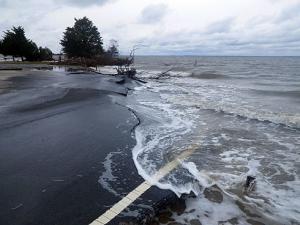Coastal resilienceHelping policymakers plan for sea level rise
A new study could help protect more than thirteen million American homes that will be threatened by rising sea levels by the end of the century. It is the first major study to assess the risk from rising seas using year 2100 population forecasts for all 319 coastal counties in the continental U.S. Previous impact assessments use current population figures to assess long-term effects of coastal flooding. The data can help policymakers develop practical adaptation strategies for protecting land threatened by frequent and repeated inundation.

One concern considered by policymakers // Source: commons.wikimedia.com
A new study by University of Georgia researchers could help protect more than thirteen million American homes that will be threatened by rising sea levels by the end of the century.
It is the first major study to assess the risk from rising seas using year 2100 population forecasts for all 319 coastal counties in the continental U.S. Previous impact assessments use current population figures to assess long-term effects of coastal flooding.
The study is based on analyses by Mathew Hauer for his doctoral work with the UGA Franklin College of Arts and Sciences; Deepak Mishra of the UGA department of geography; and Jason Evans, a former UGA faculty member now with Stetson University. It was published 14 March in the journal Nature Climate Change.
UGA reports that based on year 2100 population forecasts, the authors report that a 6-foot sea level rise will expose more than thirteen million people to flooding and other hazards from rising seas. Florida faces the most risk, where up to six million residents could be affected. One million people each in California and Louisiana also could be impacted.
Scientists believe worldwide sea levels could rise by 3 to 6 feet by 2100. Even with a 3-foot rise, population trends indicate that more than 4.2 million coastal residents in the continental U.S. would be at risk, according to Hauer.
“The impact projections are up to three times larger than current estimates, which significantly underestimate the effect of sea level rise in the United States,” Hauer said. “In fact, there are 31 counties where more than 100,000 residents could be affected by 6 feet of sea level rise.”
The data can help policymakers develop practical adaptation strategies for protecting land threatened by frequent and repeated inundation, according to Mishra.
“This research merges population forecasts with sea level rise. It gives policymakers more detailed information to help them assess how sea level rise will affect people and infrastructure,” he said.
By employing year 2100 population projections, the data also provide a more accurate measure of potential flooding risks in some of the nation’s fastest-growing communities, Hauer said. For example, more than 25 percent of the people living in major urban centers like Miami and New Orleans could face coastal flooding by the end of the century if adaptive measures aren’t taken.
“Adaptation strategies are costly, and these are areas of especially rapid population growth, so the longer we wait to implement adaptation measures the more expensive they become,” Hauer said.
With a 6-foot rise in sea level, flooding could impact more than 80 percent of the people living in America’s three most vulnerable communities: Monroe County, which is the site of the Florida Keys, and two lightly populated counties on the North Carolina coast, Hyde, and Tyrrell.
UGA notes that more than 10 percent of the population in Georgia’s coastal counties would be impacted by coastal flooding, including 18 percent of the people who live in Chatham County (Savannah) and 29 percent in Glynn County (Brunswick).
Outside of the Southeast, a 6-foot rise in sea level would put at risk more than 16 percent of the population in San Mateo County, California, just south of San Francisco, and over 10 percent of the population in Nassau County, New York, which is on Long Island just east of New York City.
— Read more in Mathew E. Hauer et al., “Millions projected to be at risk from sea-level rise in the continental United States,” Nature Climate Change (14 March 2016) (doi:10.1038/nclimate2961)
